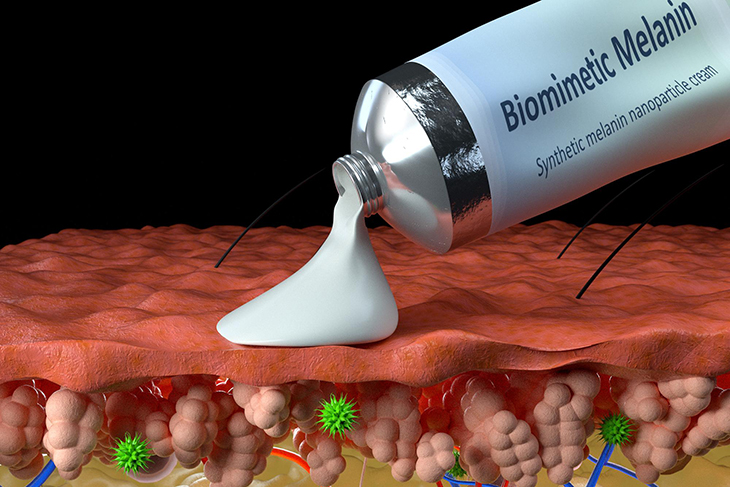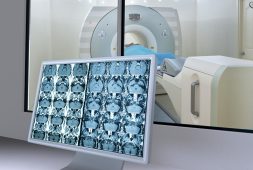The Perfect Ally To Protect Skin From Sun And Chemical Burns Comes In The Form Of A Super Melanin Cream

Northwestern University scientists have developed an innovative ‘super melanin’ skin cream that boasts the remarkable ability to continuously repair sun damage and chemical burns. This synthetic melanin, designed to mimic the natural melanin found in human skin, can be topically applied to injured skin, expediting the healing process both locally and systemically within the body.
In a recent publication in Nature Regenerative Medicine, researchers demonstrated that the biomimetic melanin cream, when incorporated into a topical application, serves as a shield against sun exposure while actively promoting the recovery of skin damaged by sun exposure or chemical burns. The mechanism behind this breakthrough involves the synthetic melanin scavenging free radicals, which are generated in response to skin injuries, such as sunburns. By neutralizing these free radicals, the cream prevents cellular damage that could otherwise lead to skin aging and potentially skin cancer.
In humans and animals, melanin provides pigmentation to the skin, eyes, and hair. Traditionally known for its role in skin darkening during sun exposure, melanin also plays a vital role in shielding cells from sun damage. This pigment, when naturally induced during sun exposure, not only provides a tan but also acts as a defense mechanism by scavenging free radicals triggered by environmental pollutants like industrial smokestack emissions and car exhaust fumes. The synthetic melanin in this innovative cream effectively harnesses these protective qualities, offering a groundbreaking solution for continuous skin healing and defense against daily environmental stressors.
“People don’t think of their everyday life as an injury to their skin,” said Dr. Kurt Lu, the co-corresponding author who also teaches dermatology and practices at Northwestern University School of Medicine. “If you walk barefaced every day in the sun, you suffer a low-grade, constant bombardment of ultraviolet light. This is worsened during peak mid-day hours and the summer season.”
Skin, shielded from aging by clothing, remains impervious to the passage of time; however, it inevitably undergoes aging processes influenced by both internal factors, such as getting older, and external environmental elements, such as air pollution.
“All those insults to the skin lead to free radicals which cause inflammation and break down the collagen,” Lu said. “That’s one of the reasons older skin looks very different from younger skin.”
The scientists enhanced the free-radical scavenging capacity of synthetic melanin engineered nanoparticles by modifying the melanin structure.
“The synthetic melanin is capable of scavenging more radicals per gram compared to human melanin,” said Nathan Gianneschi, another co-corresponding author and a professor of chemistry and pharmacology at Northwestern. “It’s like super melanin. It’s biocompatible, degradable, nontoxic and clear when rubbed onto the skin. In our studies, it acts as an efficient sponge, removing damaging factors and protecting the skin.”
The Sunscreen Booster Stays on the Surface of the Skin As It Calms the Immune System
When applied to the skin, melanin remains on the surface and does not penetrate into the underlying layers.
“The synthetic melanin stabilizes and sets the skin on a healing pathway, which we see in both the top layers and throughout the body,” Gianneschi said.
After dedicating nearly a decade to the study of melanin, the scientists conducted their initial experiment with synthetic melanin, using it as a sunscreen, and achieved success.
“Next, we wondered if the synthetic melanin, which functions primarily to soak up radicals, could be applied topically after a skin injury and have a healing effect on the skin?” Gianneschi said. “It turns out to work exactly that way.”
“You are protecting the skin and repairing it simultaneously,” Lu said. It’s continuous repairing process is shown in the team’s video…
The cream has the potential to be applied for blisters and open sores, simultaneously moderating the immune system.
The outermost layer of mature skin cells, known as the stratum corneum, interacts with the underlying epidermis. Functioning as the interface between the body and the external environment, this surface layer receives signals. By alleviating the harmful inflammation at this interface, the body can initiate the healing process rather than escalating inflammation further.
“This means that stabilizing those upper layers can lead to a process of active healing,” Lu said.
In the laboratory setting, scientists conducted an experiment involving the application of a chemical to induce a blistering reaction on a human skin tissue sample in a petri dish. The resultant effect manifested as a pronounced separation of the upper layers of the skin, exhibiting a high level of inflammation akin to a poison ivy reaction.
Following this initial stage, the researchers allowed a period of time to elapse before administering their topical melanin cream to the damaged skin. Over the course of the first few days, the cream played a pivotal role in triggering an immune response. Initially, it facilitated the recovery of the skin’s inherent radical scavenging enzymes, subsequently putting a halt to the production of inflammatory proteins. This orchestrated a cascade of responses, leading to a significant acceleration in the healing process. Notably, the melanin cream not only promoted healing but also preserved the integrity of the healthy skin layers beneath.
In stark contrast, the samples that did not undergo treatment with the melanin cream exhibited a persistent blistering effect, underscoring the efficacy of the cream in mitigating the adverse effects of the induced skin damage.
“The treatment has the effect of setting the skin on a cycle of healing and repair, orchestrated by the immune system,” Lu said.
Melanin, a pigment found in the human body, exhibits remarkable protective properties against various toxins, including nerve gas. The investigation into melanin’s capabilities is being supported in part by the U.S. Department of Defense and the National Institutes of Health. Researchers have demonstrated that by incorporating melanin, a military uniform can be dyed black, effectively absorbing nerve gas. Moreover, their findings indicate that melanin shields biological tissue from high-energy radiation, suggesting its potential as a therapeutic agent for treating skin burns resulting from radiation exposure.
Beyond its defense against nerve gas and radiation, melanin possesses the capacity to absorb heavy metals and toxins naturally. Through synthetic modifications, the researchers have further enhanced its ability to optimize the absorption of these harmful molecules. Professor Gianneschi highlighted the successful engineering of a synthetic version of melanin that proved non-irritating in a recent human trial. This breakthrough holds promise for future applications, potentially offering treatment options for cancer patients undergoing radiation therapy. The multifaceted protective attributes of melanin underscore its significance in developing innovative solutions for both military and medical contexts.



